Unprovoked shark attacks
Shark attacks are on the increase due to more people being involved in activities like surfing and scuba diving. I saw this article in the National Post and the graphic showing deaths and shark attacks for the last 100 years, should make surfers very nervous. Blue or pink shows the person survived the attack, black means they didn’t.
Red Sea Shark Attacks

70 year old woman killed by shark in front of the Hayat Regency Hotel in Sharm el-Sheikh
A shark killed a 70-year-old German woman today. The attack happened in the sea directly in front of the Hayat Regency Hotel in Sharm el-Sheikh.
This is the second fatality due to shark attack in Egypt this year and follows a spate of attacks in the past few weeks.
The Egyptian Environment Ministry had claimed earlier in the week to have caught the sharks implicated in the attacks.
They displayed the sharks, a 7 foot Mako shark weighing 330 pounds and an 8 feet long Oceanic White Tip, weighing 550 pounds. The sharks were taken to Ras Mohammed Conservation Center to be dissected to see if there were any human remains inside.
Local divers who had seen the shark before the attack were adamant that the captured sharks were not the animals involved in the attacks. Even so the beaches were reopened and declared safe by the authorities.
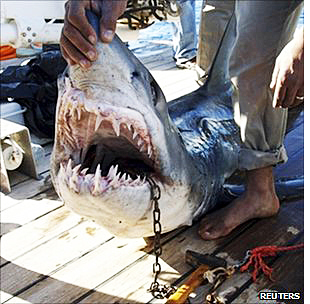
Authorities claimed to have caught 'killer shark'
Mohammed Salem, director of Sinai Conservation said in an interview, “Usually these kinds of sharks don’t attack human beings but sometimes they have trouble with their nervous system and they accidentally go after people.”
In January of this year a French woman who was snorkeling in the Red Sea near Marsa Alam was attacked and killed by an unidentified shark. At the time the authorities blamed the woman for the attack, claiming: ‘This very rarely happens. It seems that the victim aggravated the shark or presented it with food, which caused a change in the shark’s behaviour,’
This latest fatal attack prompted tourism Minister Zoheir Garranah to order all beaches near Egypt’s Red Sea resort town of Sharm el-Sheikh be closed to the public and all maritime activities–including diving–be halted until the authorities could capture the shark.
One thing is for sure, a shark will be caught very soon, whether it’s the ‘killer’ remains to be seen, but the authorities cannot afford to close down one of the world’s most popular tourist destinations for watersports.
If someone else is killed, I wonder what excuse the authorities will dream up next?
Shark attack practical joke
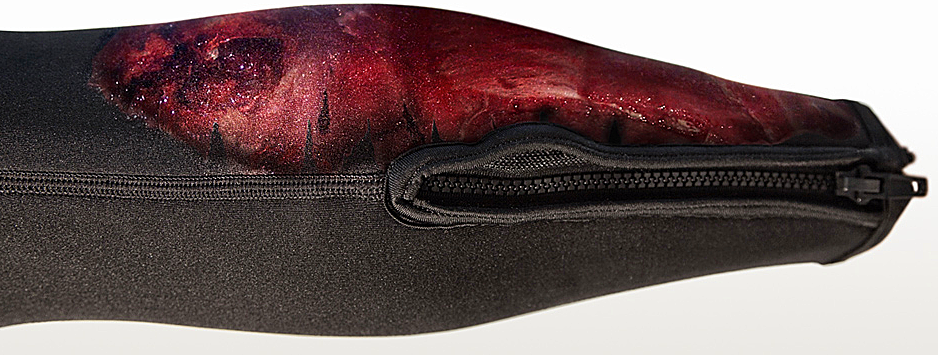 I love this wetsuit, designed to look as though you’ve escaped a savage shark attack. It really is gruesome and I can imagine the reaction from other swimmers/surfers if you walked out of the sea wearing this suit. It does feel however that you’d be tempting fate. The designer is Diddo, who is obviously a very creative type. Although not yet in production, it’s my guess these will be collectors items in years to come. My absolute favourite is the Whaleshark patterned wetsuit. Funninly enough there’s no seal pattern available, now that would require big balls.
I love this wetsuit, designed to look as though you’ve escaped a savage shark attack. It really is gruesome and I can imagine the reaction from other swimmers/surfers if you walked out of the sea wearing this suit. It does feel however that you’d be tempting fate. The designer is Diddo, who is obviously a very creative type. Although not yet in production, it’s my guess these will be collectors items in years to come. My absolute favourite is the Whaleshark patterned wetsuit. Funninly enough there’s no seal pattern available, now that would require big balls.
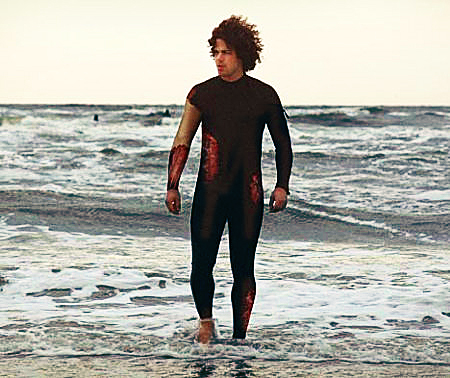
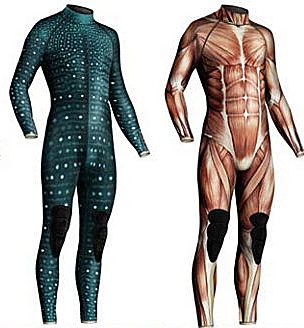
Shark attacks and blood myth busted!
 I’ve always believed that sharks are attracted to the ‘smell’ of blood or urine in the water. So advice given to divers/snorkelers that to avoid shark attacks, you shouldn’t dive if you are bleeding, or you are a women who is menstruating and you should never urinate in your wetsuit, made sense. That is until I read this article by Devin Powell, Inside Science News Service. Read it for yourself and see if you feel reassured. “Everyone knows that sharks have an amazing sense of smell. Toss a chunk of salmon into the shark tank at the Monterey Bay Aquarium in California, and you can see it in action. “They know right away when the scent hits the water,” said Erin Carter, an aquarist at the Monterey Bay Aquarium who works with several species of sharks. “If it’s fresh food that’s just been delivered that morning from the dock, they’ll just go nuts for it.”
I’ve always believed that sharks are attracted to the ‘smell’ of blood or urine in the water. So advice given to divers/snorkelers that to avoid shark attacks, you shouldn’t dive if you are bleeding, or you are a women who is menstruating and you should never urinate in your wetsuit, made sense. That is until I read this article by Devin Powell, Inside Science News Service. Read it for yourself and see if you feel reassured. “Everyone knows that sharks have an amazing sense of smell. Toss a chunk of salmon into the shark tank at the Monterey Bay Aquarium in California, and you can see it in action. “They know right away when the scent hits the water,” said Erin Carter, an aquarist at the Monterey Bay Aquarium who works with several species of sharks. “If it’s fresh food that’s just been delivered that morning from the dock, they’ll just go nuts for it.”
But can these aquatic bloodhounds really detect a drop of blood in an Olympic-sized swimming pool or a mile away in the ocean, as the popular legend suggests?
This myth smelled a little fishy to scientists in Florida, who decided to put it to the test. They found that sharks don’t live up to their reputation in the movies, documentaries, and pages of scientific journals. Although a shark’s sense of smell is extremely keen, it’s no better than that of a typical fish.
“From what we know now, they can’t smell a drop of anything in an Olympic-sized swimming pool,” said Tricia Meredith, a biologist at Florida Atlantic University in Boca Raton.
Blood In The Water
The idea that sharks have the best noses in the ocean may be partly inspired by our fears of the toothy predators.
“People are afraid if they pee or bleed into the ocean, sharks are going to sniff them out and eat them,” said Meredith.
In scientific circles, though, the shark’s smelly reputation is based on its anatomy. Unlike human beings, sharks have separate openings for breathing and smelling. Gills on the sides of their heads capture oxygen in the water, while two nostrils at the front of the face pull water into a nasal chamber where smells are detected.
The amount of tissue in this cavity, folded over plates called lamellae, is huge in sharks compared to other fishes. Scientists have long thought that this greater surface area gives sharks a better sense of smell.
“It’s a pretty logical jump to make, but no one had actually tested it,” said Meredith.
To test this assumption, Meredith studied animals from five different species of elasmobranchii — the scientific
subclass that includes sharks — captured in waters off the coast of Florida. They ranged from flat skates and stingrays to pointy-nosed lemon sharks and bonnethead sharks with hammer-like heads.
Each elasmobranch spent time in a tank with equipment attached to its nose: a tube that released 20 different kinds of amino acids — the building blocks of animal proteins that lead sharks to their prey — and an electrode that measured the electrical impulses in the nasal cavity generated in response to smells.
The recordings showed that, on average, sharks with more surface area in the folds inside their snouts were no better at detecting faint smells.
The five tested shark species had just about the same sensitivity as each other and as non-shark fish that have been tested in other studies. At their best, the sharks detected about one drop of scent dissolved in a billion drops of water.
One explanation for this is that being any more sensitive could actually confuse a shark. One part in a billion is roughly the natural background concentration of amino acids floating around in coastal waters. If sharks were adapted to detect smaller concentrations, it might be difficult for them to distinguish the byproducts of a potential meal from random bits of aquatic flotsam and jetsam.
“Imagine you were super-sensitive to sound, and you could hear whispering really well,” said Meredith. “That would be awful if you always lived in a room with a stereo blaring.”
When it comes to the myth of sharks having an unrivaled sense of smell, her conclusion is: “Myth busted.”
But for Jelle Atema, who studies shark olfaction at Boston University, the myth is only mostly busted. Although impressed by the new research, he said that the science leaves a little room for further exploration.
The electrodes in Meredith’s experiment work by adding up the entire electrical response of millions of smell receptors to a scent. Atema hopes to get a closer look by examining single cells — some of which might be specialized to respond to certain smells.
“Pretend that these smell receptors are a singing choir,” said Atema. “The choir itself may not be louder, but some voices may be singing louder than others if you listen closely.”
Meredith’s study focused on coastal sharks. Atema wonders if the same applies to sharks that live in the open ocean, where the background concentration of smells is lower.
His work has also shown that aquatic animals can detect extremely small concentrations of other chemicals that are not amino acids. Tuna can smell one drop of the chemical tryptophan — a common compound in turkey meat — dissolved in trillions of drops of water.
For now though, the best scientific evidence suggests an update to the popular myth: sharks can smell a drop of blood in a volume of water about the size of a backyard swimming pool. It’s still impressive, but hardly as terrifying as Hollywood would have us believe”.
Bahamas shark feed video
Wonderful video footage of placid sharks being hand fed by a ‘hypnotist’ scuba diver. Check out the shark in trance at approx 2 mins 30 secs.
Beautifully shot and the video shows how gentle sharks can be.
Body parts found in shark ‘belong to missing sailor’
I suppose people deal with trauma differently and I really shouldn’t indulge in slagging off a guy just because he’s an investment banker… but, this report struck me as somewhat bizarre. Imagine you’ve just caught an enormous Tiger Shark and as you attempt to land it, the beast regurgitates a human leg. When you related the tale, would you laugh? Well the banker is quoted as saying: “I always watch that before I go out,” Mr Simmons laughed. LAUGHED? Dear God does this just sum up the attitude of bankers? Read the original report below.
JUST AS the deep sea fisherman was about to cut the hook from the shark’s wide open mouth and let him go, out jumped a human foot.
“Everything was intact from the knee down,” said Bahamian investment banker Humphrey Simmons, “it was mangled, but there was still flesh on the bone.”

That ended a day of fishing for Mr Simmons and his two companions who spent most of the morning trying to get away from sharks.
By the time the unusually heavy Tiger shark was landed at the Defence Force’s Coral Harbour base and his distended body cut open, the body of a man, minus his head, was found. The leg that the shark had regurgitated was the man’s left leg. Inside was his severed right leg, two severed arms and a torso in two sections.
Obviously, as Mr Simmons’ 10-year-old daughter observed, this shark had its prey all to himself. There was no sign that another shark had fought over the body. It is believed that the man had drowned before the shark swallowed him.
Mr Simmons, of Cable Beach, a banker with Xanthos Investment, and his two deep sea fishing companions — Keith Ferguson and Stanley Bernard — left Marshall Road, South Beach before 6am Saturday in Mr Simmons 30-foot Pursuit, “Azulardo.”
“We went 35 miles south of Nassau and started fishing about 7.45am,” said Mr Simmons. “After about 45 minutes we pulled up a fish, and a shark took it.
“We left the area and went two miles further south and let out the lines again. Keith pulled up his line and before reaching the surface the shark had broken the line.”
The weather was calm with winds about 4mph blowing from the southwest.
“I always watch that before I go out,” Mr Simmons laughed.
Trying to get rid of the sharks, Mr Simmons moved again, this time about two to three miles further south. By then they were about 38 miles from Nassau.
“While pulling up my line,” he said, “I noticed that it was extra heavy. I called “Boy” (Stanley Bernard) and asked him to go get the shot gun.”
By then the men were fishing in water about 1,000 feet deep. They had decided against landing the shark because there was too much tension on the line.
“I then thought about what might have been going through that shark’s mind,” said Mr Simmons. “Usually when you catch a shark on the line, and are pulling him up, when he sees sunlight, he heads back down, and either cuts the line or breaks it.
“While pulling him up there was also a grouper on the line, and he was trying to get the grouper, but I had both on my line. He came up with his mouth wide open, but he couldn’t get the grouper because it was also on my line.”
As the shark neared the surface, Mr Bernard shot him several times in the head.
“We tied the rope around his tail fin, and pulled him towards the boat. We were going to cut the hook out of his mouth and let him go when he regurgitated a human foot — intact from the knee down. It was now about 10am.”
The men then tried to get BASRA and the Defence Force, but could raise neither — “it was probably because they were out of range for our VHF radio,” Mr Simmons commented.
They decided to take the left leg and the shark to Nassau.
“There was so much stink coming from the shark’s belly and the belly was so huge that we thought that there might be more bodies inside,” said Mr Simmons.
At about 10.30am the men headed for Nassau, dragging the heavy shark behind. About a half hour later they saw a Defence Force boat and flagged it down.
The Defence Force’s Enduring Friendship vessel EF-28 pulled up alongside them, heard their story and took the shark on board. It was then about 11.30am when they followed the Defence Force boat to Nassau, arriving at about 12.30pm at the Coral Harbour base.
The shark’s body was offloaded, cut open and inside was the remains of a headless man.
Mr Simmons said he was a “black man, of heavy build and heavy structure. He had neither clothes nor any identifying marks.”
Police are now awaiting DNA results to tell them if the remains belong to one of three men who are still missing at sea.
The Royal Bahamas Defence Force said still reported missing are 62-year-old Frank Brown, Sr, and 47-year-old Delton Newton, who disappeared after their boat experienced engine trouble in waters off Clifton Pier last week. A man who disappeared from a boat in Acklins last week has also not yet been found.
However, Mr Simmons said that Mr Frank Brown Jr stopped at his home, looked at the photographs of the body parts and confirmed that they were not those of his father.
Shark misinformation and media hysteria
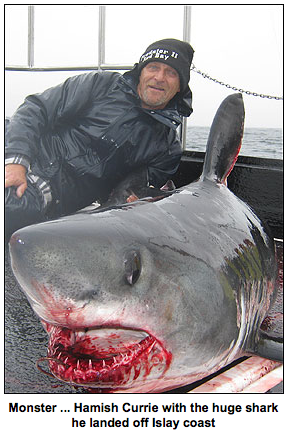 Just a few days ago the british newspaper the Sun reported that a scottish angler had caught a ‘terrifying’ Porbeagle shark.
Just a few days ago the british newspaper the Sun reported that a scottish angler had caught a ‘terrifying’ Porbeagle shark.
The man poses with his catch, with the bloodied mouth facing camera. He goes on to warn readers that hundreds of these vicious beasts are just yards off the beach.
As much as I believe we should protect ourselves against a possible shark attack, it should be noted that Porbeagle sharks attacking humans is extremely rare. In fact only two unprovoked attacks have ever been reported. Which makes this newspaper article irresponsible. No doubt the captor of the beast, who just happens to own a charter fishing boat, will take other anglers out to catch their own monster.
The man in the picture claimed to have returned an even bigger shark because as he claims, “I would never kill a fish like that – I’m a conservationist.”
Read the news article below:
Great fright shark
SHARK hunter Hamish Currie poses with his massive prize catch – a vicious 300lb JAWS.
Determined Hamish battled with the menacing 8ft beast for 45 minutes before finally landing the monster.
And last night Hamish warned there are hundreds more terrifying porbeagle sharks – like the one he caught just 100 yards off the coast of Islay in Argyll – prowling British waters.
He said: “It was a hell of a battle – 45 minutes of sheer hell. She didn’t come on board easy.
“The porbeagle is a very vicious and aggressive shark. She is the closest relative to Jaws – the great white shark.
“They’re a hungry bunch. They have even been known to try to eat through a boat’s fuel lines.
Shark week
 I love ‘Shark Week’ on the Discovery channel. It’s actually been running for 23 years, which just goes to show how fascinated we are with everything to do with sharks. The trouble is with the series is while they ‘support’ sharks and claim that Shark Week is also a powerful platform to raise awareness about the dangers sharks face from commercial fishing, which kills more than 100 million sharks worldwide each year, the programme uses sensationalist stories about shark attacks to publicise the TV show.
I love ‘Shark Week’ on the Discovery channel. It’s actually been running for 23 years, which just goes to show how fascinated we are with everything to do with sharks. The trouble is with the series is while they ‘support’ sharks and claim that Shark Week is also a powerful platform to raise awareness about the dangers sharks face from commercial fishing, which kills more than 100 million sharks worldwide each year, the programme uses sensationalist stories about shark attacks to publicise the TV show.
This year, Discovery is donating money to support conservation organization Oceana’s campaign to ban the practice of shark finning, where the fins of a shark are sliced off and the remainder of the animal is left to die in the water, which is a very worthwhile cause but they know what their viewers want to see and that’s shark attacks. Take a look at the publicity shots and video for this years series. Of course the movie Jaws did the damage, countless numbers of people were left traumatized by the film. Looking back the special effects were not that impressive but the music alone was terrifying enough.
So is it any wonder that film makers and documentary producers continue to play on our fear of sharks? They are after all the closest thing we have to monsters on our planet.
<a href=”http://www.hypersmash.com/hostgator/” id=”RM50148159″>HostGator review</a>